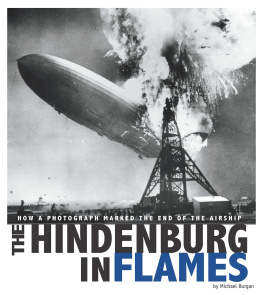
2 Flash Points
May 6, 1937
e German airship Hindenburg is about to land in
Lakehurst, New Jersey. Aer trips, this is the rst
time the airship has crossed the Atlantic Ocean that
year. Hundreds of people have gathered for its arrival.
e crowd waits for the airship, which was delayed by
storms over Lakehurst. Finally, the silver rounded nose of
the airship peeks over the treetops. It dris in slowly before
dropping lines, which the ground crew hurries to pick up.
As the airship is towed toward its mooring , ames
suddenly erupt from the back of the ship. Members of the
ground crew begin to run as the orange ame quickly turns to black
smoke. en, there is a series of explosions. Within seconds,
the entire airship is on re. It comes crashing to the ground.
One member of the ground crew and passengers die, witnessed by
friends and family in the crowd. is is the end of airship travel.
The
Hindenburg
mooring: a place where
a boat or ship is tied up

Disaster!
The Hindenburg was feet (245 meters)
long, which is longer than two football elds.
Did you know?
Airships are also called zeppelins, after
Count Ferdinand von Zeppelin. Von Zeppelin
designed one of the rst airships in 1874.

Bad Weather
at day, the weather over Lakehurst was bad.
ere had been several storms. e captain
had been told that he couldnt land until the
weather improved. He waited for several
hours. Eventually the storms began to clear.
e captain was told it was okay to land.
Traveling in Luxury
Traveling on an airship was popular.
It was also a luxury. e Hindenburg
had a fancy dining room, live piano
music, and comfortable cabins. It was
twice as fast, and twice as expensive,
as traveling on a ship at sea.
4 Flash Points
How and Why
Accidents and disasters oen have more than one cause.
Many dierent things come together to cause events that
can greatly impact the future. Take a moment to explore
some of the things that led to the Hindenburg s ery crash.

Flammable Gas
e large balloon on top of the airship
was lled with gas. is helped it stay
in the sky. e Hindenburg s tank was
built to be lled with helium, which
does not burn. e United States was
the worlds top manufacturer of helium.
But they wouldnt sell it to other
countries. ey were afraid it would
be used to make weapons. Instead,
the Germans lled the Hindenburg s
tank with hydrogen. Hydrogen catches
re very easily and burns fast.
Static Electricity
Nobody knows for sure
what actually started the
re. ere was a hydrogen
leak at the back of the
ship. Any small spark
could have started the re.
Many experts think it was
static electricity. A spark
from the static could
have lit the gas on re
and destroyed the ship.
Disaster!

What Happened Next
One of the people who watched the Hindenburg s
crash was reporter Herbert Morrison.
Morrison was recording a news segment.
e radio planned to play it later in
Chicago. His news report quickly
turned to horror as he watched the
airship burn. Oh the humanity! he
cried. Later, people laid those words
over newsreel lms of the ship crashing
and burning. is recording is now very
well-known.
ere were people on board the Hindenburg .
A total of people died because of the crash. Twenty-six of
them died during the crash or in the re. Another died in the next few
days from their injuries. But most of the passengers and crew survived.
e video of the Hindenburg s crash was played all over the world. It was
the rst public broadcast that went around the globe. Everybody could see
the dramatic lm of the huge ship on re. People were shocked and upset.
ey lost faith in airships. Airships seemed scary and dangerous.
6 Flash Points
newsreel: a short
video about news
or current aairs
Did you know?
In 1935, the Hindenburg ew between
Germany and the United States
times. In that time, it carried more
than 1,000 passengers.

Disaster!
The Hindenburg was also carrying
about 17,000 pieces of mail when it
crashed. Of those, were recovered.

Ripple Effects
A single event, no matter how big or small it may
seem at the time, can have a big impact on the future.
e Hindenburg s crash had many far-reaching eects.
Nazi Airship
Destroyed
The Hindenburg
was a German-made
airship. It was owned
and operated by the Nazi
Party, the political group
in charge of Germany at
the time. Its loss was a
blow to the Nazi Party.
It was also a national
embarrassment
for Germany.
Public
Disaster
The Hindenburg crash was not
the most deadly airship accident.
However, it was dierent from the
others in one important way. The
Hindenburg s destruction was
very public. Everyone saw the
video, and afterward, the
production of airships
stopped.
8 Flash Points

End of an Era
Now, there are almost
24,000 airplane ights
in the United States
every day. That adds up
to million passengers
every year. There are a
few airships in existence
today, but they are no
longer used to carry
passengers.
Change to
Planes
Airplane technology was
advanced during World War II






















